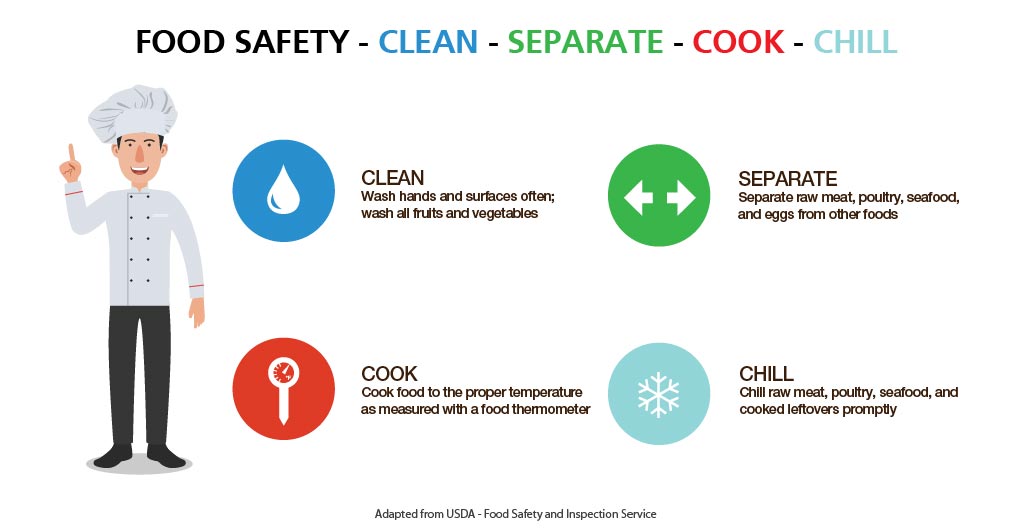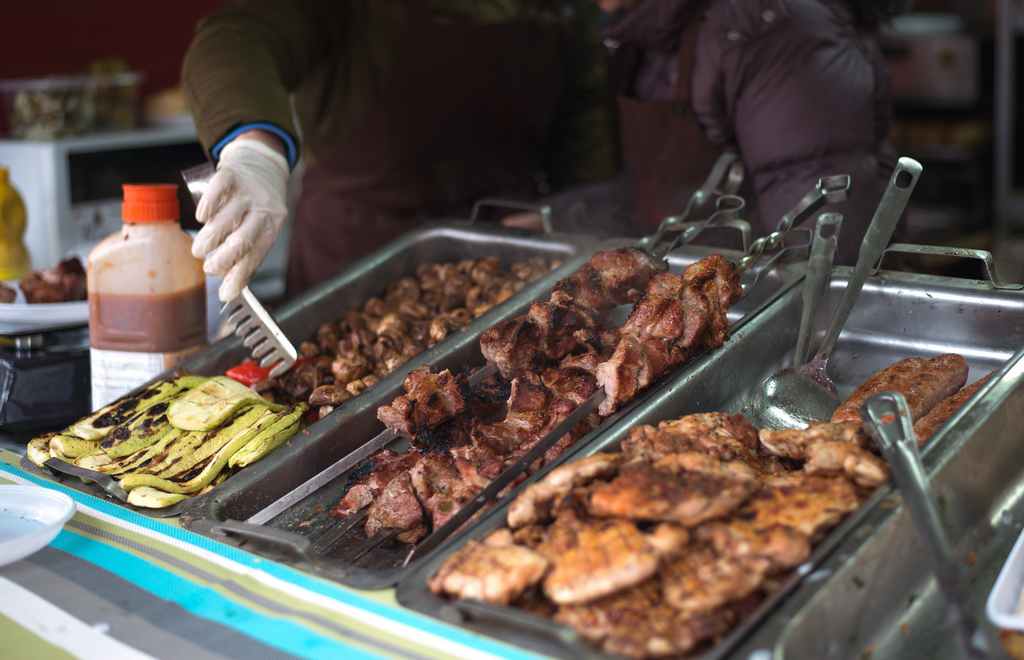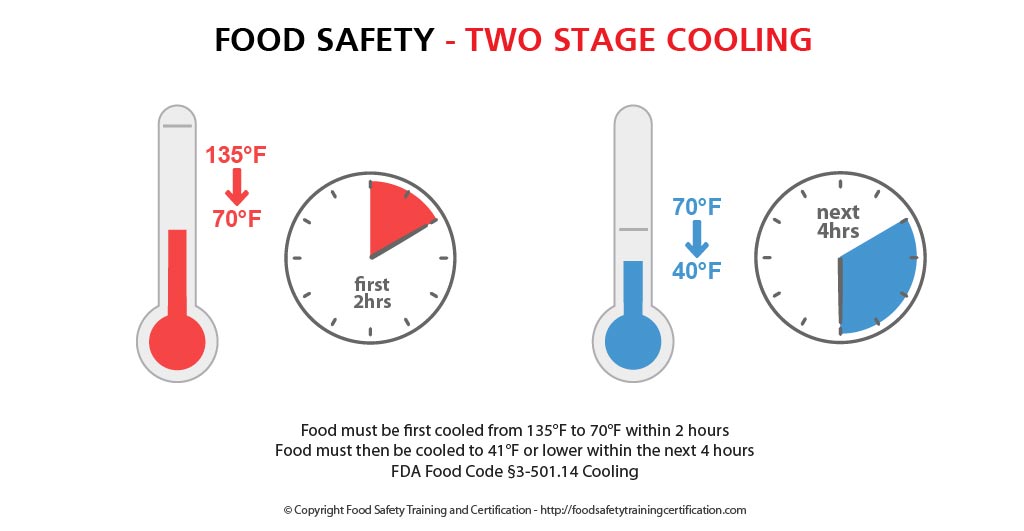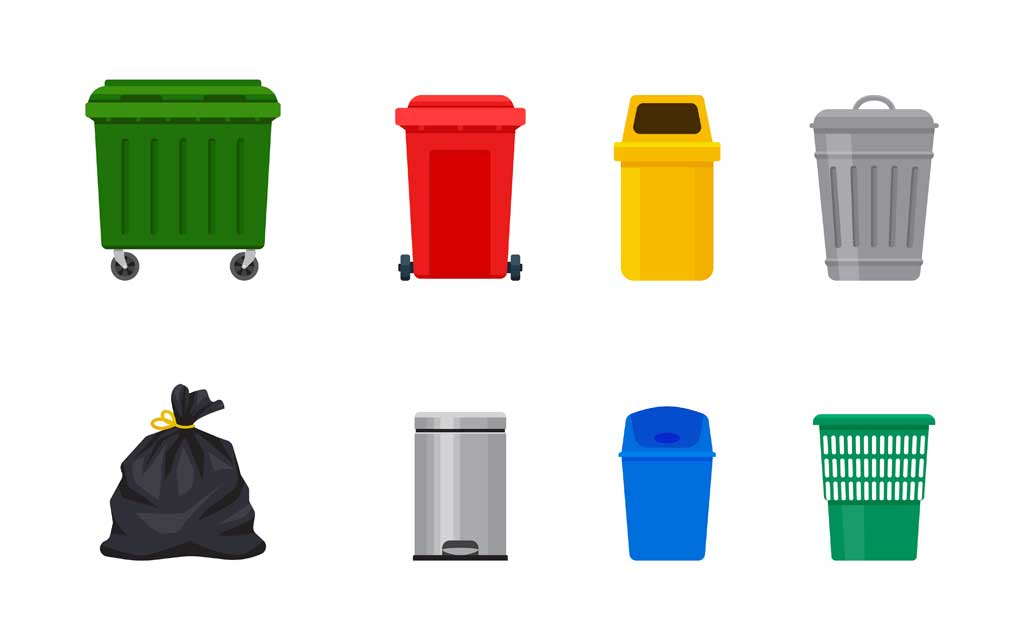To prepare and sell food at fairs and festivals, typically a food vendor need a vendor’s license or food handler’s permit – and there should to be a person-in-charge – food manager certified.



Warmer weather, cooking outdoors, and part-time vendors increases the chance of bacteria multiplying on or contaminating food that can make you sick.
Temporary food vendors pose a risk because they are often part-time cooks and may not have a complete knowledge of proper food safety practices or procedures – or may never have taken a food safety training course – thus increasing the chance of improperly handling food.



Get Food Handler Trained or Manager Certified
A temporary restaurant is any establishment operating temporarily in connection with any event where food is prepared or served for consumption by the public. Examples of events include: fairs, carnivals, circuses, festivals, concerts or any other public gathering. Generally, they are commonly referred to as food booths and to operate, you probably have to obtain a temporary restaurant license from the county where the event will be held.
A lot of people working at food booths have never cooked for the public before, so it is essential that they take a food handler training course to understand the basics of food safety.
Likewise, each food booth should have at least one person certified as a food protection manager. This person-in-charge (PIC) is responsible for knowing the food sanitation rules and the procedures within your vendor booth. This person should also provide employees with information they need to perform their job.
- Learn about proper hygiene, cross contamination, cold and hot food safety, foodborne pathogens, and best practices to prevent foodborne illness.
- Food Manager Training & ANSI Certification - $99.00
- Food Handler Training - only $7.00!
- HACCP Training: 16hr/4hr/1hr
- Food Allergy Training - $15.00
- Enter Promo "train10off" at Checkout
Temperature Danger Zone
One of the critical factors in food safety is controlling temperature. Bacteria grows very slowly below 40°F, multiply rapidly between 40°F and 140°F, and are destroyed above 140°F.



General Food Safety Practices
Remember that food safety practices should be the same at fairs as they are at restaurants and at home: Clean, Separate, Cook, and Chill.



Clean
- Keep food contact surfaces clean and sanitized.
Clean with a wiping cloth, rinse with clean water then sanitize with a spray-on bleach solution (1/2 teaspoon of bleach/quart of water). The wiping cloth used to clean surfaces should be maintained in a bucket of bleach solution (1 tablespoon of bleach/2 gallons of water). This should be changed every two hours. The wiping cloth is for cleaning (not sanitizing). - Wash dishes properly.
Wash dishes with warm soapy water, rinse, immerse in bleach solution (1 teaspoon bleach/gallon of water), air dry. - Utensil Washing.
Provide two large buckets or tubs (3-5 gallon capacity) for utensil washing. The first container shall have soapy water; the second one a sanitizer solution with one-capful of bleach for every gallon of water in the container. The buckets or tubs must be large enough to wash the largest utensil. - Hand Washing.
If a hand washing sink is not in the food stand, a temporary hand washing system can be easily set up. Your hands can easily spread bacteria around the vendor booth and onto food. This is why it’s important to always wash your hands thoroughly with soap and warm water before starting to prepare food and after touching raw food such as meat, poultry and vegetables. - Hand contact with food.
Minimize bare hand contact with ready-to-eat food. Use disposable gloves, tissues, tongs or other utensils whenever possible.
Separate
Separate raw food, including meat/fish and vegetables from ready-to-eat foods.
Raw foods such as meat, fish and vegetables may contain harmful bacteria that can spread very easily to anything they touch, including other foods, worktops, chopping boards and knives.
It’s especially important to keep raw foods away from ready-to-eat food, such as salad, fruit and bread. This is because these types of food won’t be cooked before you eat them, so any bacteria that get onto the food won’t be killed.
Cross-contamination is when juices from uncooked foods come in contact with safely cooked foods, or with other raw foods that don’t need to be cooked, like fruits and vegetables. The juices from some raw foods, like meats and seafood, can contain harmful bacteria that could make you and your family sick.



Cook
Maintaining food at a safe temperature while cooking and reheating are critical safe food handling practices.
- Thaw frozen food in a refrigerator overnight, or thaw it under cold running water in a food preparation sink for no more than two hours. Do not thaw food by leaving it at room temperature.
- Prepare food inside the booth only. Barbecue or grilling equipment should be located outside the booth in an area that minimizes overhead contamination.
- When the cooking process starts, it must be taken to completion. Never partially cook a food item, such as ground beef or a turkey, and finish cooking at a later date.
- Any foods being reheated should reach at least 165ºF before hot holding or service.
- Do not attempt to reheat food in a crock-pot, chafing dish or other hot-holding device. Hot-holding equipment is not designed to reheat food quickly. It takes too long to reheat the food and allows bacteria to grow.
- Hot food left over at the end of the day may not be re-used the next day.
| Food | Type | Internal Temperature (°F) |
|---|---|---|
| Ground meat and meat mixtures | Beef, pork, veal, lamb | 160 |
| Turkey, chicken | 165 | |
| Fresh beef, veal, lamb | Steaks, roasts, chops Rest time: 3 minutes | 145 |
| Poultry | All Poultry (breasts, whole bird, legs, thighs, wings, ground poultry, giblets, and stuffing) | 165 |
| Pork and ham | Fresh pork, including fresh ham Rest time: 3 minutes | 145 |
| Precooked ham (to reheat) Note: Reheat cooked hams packaged in USDA-inspected plants to 140°F | 165 | |
| Eggs and egg dishes | Eggs | Cook until yolk and white are firm |
| Egg dishes (such as frittata, quiche) | 160 | |
| Leftovers and casseroles | Leftovers and casseroles | 165 |
| Seafood | Fish with fins | 145 or cook until flesh is opaque and separates easily with a fork |
| Shrimp, lobster, crab, and scallops | Cook until flesh is pearly or white, and opaque | |
| Clams, oysters, mussels | Cook until shells open during cooking |
Chill
- Cool foods from 140°F to 70° F within four hours, and 70°F to below 41°F within an additional two hours.
- Develop a plan for storing and holding large quantities of food that need to be temperature controlled below 41°F.
- Electric or gas powered coolers are often set between 36°F and 38°F to maintain food at 41°F or lower.
- Coolers with ice are intended for smaller amounts of food for a short time period or for foods such as beverages (i.e.) that are NOT required to be held at 41°F or lower.



Waste Disposal
- Provide an adequate number of trash cans with trash bag liners. Properly dispose of all trash at the end of the event.
- Liquid waste (e.g. dirty water bucket for hand washing) must be disposed into a sanitary sewer and never on the surface of the ground or in a storm drain.



Fire Safety Basics: Staff Training
Train your staff with these fire safety basics:
- Use Proper Fire Extinguisher. Provide a type A/B/C fire extinguisher in the booth if flammable liquids or gas are used.
- Use a fire extinguisher appropriately. An acronym you may find helpful is PAST – pull out the pin, aim at the base, make a sweeping motion, (be) ten feet away. Vendors should probably have readily accessible at least one fully charged and operational UL – rated type 2A 10 – BC dry chemical fire extinguisher of at least 2 lbs. net capacity in each location using an open flame or electric heat device.
- Cooking Location. Locate cooking equipment in a safe area outside the booth that minimizes customer interference. Keep cooking equipment 2 feet away from any flammable booth or canopy material.
- Clean up the grease. Cleaning exhaust hoods is especially important, since grease buildup can restrict air flow. Be sure to also clean walls and work surfaces; ranges, fryers, broilers, grills and convection ovens; vents and filters.
- Never throw water on a grease fire. Water tossed into grease will cause grease to splatter, spread and likely erupt into a larger fire.
- Remove ashes from wood- and charcoal-burning ovens at least once a day.
- Store flammable liquids properly. Keep them in their original containers or puncture-resistant, tightly sealed containers. Although a food truck kitchen is very small, you should attempt to store containers in well-ventilated areas away from combustible supplies, food, food-preparation areas or any source of flames.
- Tidy up to avoid fire hazards. Store paper products, linens, boxes and food away from heat and cooking sources. Properly dispose of soiled rags, trash, cardboard boxes and wooden pallets at least once a day.
- Use chemical solutions properly. Use chemicals in well-ventilated areas, and never mix chemicals unless directions call for mixing. Immediately clean up chemical spills.
- Electrical Cords. Minimize use of electrical extension cords and protect electrical lines from water and thoroughfares.
- First Aid. Always have a first aid kit on site.
The National Fire Protection Association (NFPA) offers grill safely tips to prevent fires:
2019 State Fair Directory
State fairs, originally held to celebrate the harvest, have grown into enormously popular events.
- Alabama National Fair
October 4 – 14, 2019 - Alaska State Fair
August 22 – September 2, 2019 - Arkansas State Fair
October 11 – 20, 2019 - Arizona State Fair
October 4 – 27, 2019. Closed Mondays and Tuesdays. - California State Fair
July 12 – July 28, 2019 - Colorado State Fair
August 23 – September 2, 2019 - Connecticut Fairs
Multiple Dates - Delaware State Fair
July 18 – 27, 2019 - Florida State Fair
February 6 – 17, 2020 - Georgia National Fair
October 3 – 13, 2019 - Idaho State Fair
August 16 – 25, 2019 - Illinois State Fair
August 8 – 18, 2019 - Indiana State Fair
August 2 – 18, 2019 - Iowa State Fair
August 8 – 18, 2019 - Kansas State Fair
September 6 – 15, 2019 - Kentucky State Fair
August 15 – 25, 2019 - Louisiana State Fair
October 24 – November 3, 2019 - Maine State Fair
August 8 – 17, 2019 Skohegan
July 25 – August 3, 2019 Bangor - Maryland State Fair
August 22 – September 2, 2019 - Massachusetts State Fair
September 13 – 29, 2019 - Michigan State Fair (Upper Peninsula)
August 12 – 18, 2019 - Minnesota State Fair
August 22 – September 2, 2019 - Mississippi State Fair
October 2 – 14, 2019 - Missouri State Fair
August 8 – 18, 2019 - Montana State Fair
July 26 – August 3, 2019 - Nebraska State Fair
August 23 – September 2, 2019 - New Hampshire State Fair
August 30 – September 2, 2019 - New Jersey State Fair
August 2 – 11, 2019 - New Mexico State Fair
September 5 – 15, 2019 - New York State Fair
August 21 – September 2, 2019 - North Carolina State Fair
October 17 – 27, 2019 - North Dakota State Fair
July 19 – 27, 2019 - Ohio State Fair
July 24 – August 4, 2019 - Oklahoma State Fair
September 12 – 22, 2019 - Oregon State Fair
August 23 – September 2, 2019 - Pennsylvania Fairs
Multiple Dates & Locations, 2019 - South Carolina State Fair
October 9 – 20, 2019 - South Dakota State Fair
August 29 – September 3, 2019 - Tennessee State Fair
September 6 – 15, 2019 - Texas State Fair
September 27 – October 20, 2019 - Utah State Fair
September 5 – 15, 2019 - Vermont State Fair
August 13 – 17, 2019 - Virginia State Fair
September 27 – October 6, 2019 - Washington State Fair
August 30 – September 22, 2019 (closed Tuesdays and September 4) - West Virginia State Fair
August 8 – 17, 2019 - Wisconsin State Fair
August 1 – 11, 2019 - Wyoming State Fair
August 13 – 17, 2019






